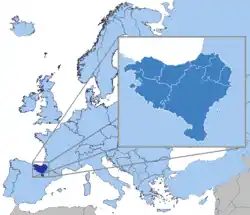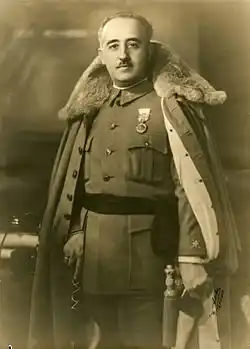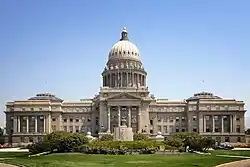
The Basque conflict was a politico-military conflict fought by Basque separatists in northern Spain and south-western France between 1959 and 2011. The conflict had its roots in the unique cultural elements of Basque society and the perception of the Basque people as being distinct from mainstream Spanish and French society. The conflict was particularly acute in Spain, a country with a strong regional separatism in many distinct parts of the country. A group by the name of Euskadi Ta Askatasuna (ETA) led the opposition to the Spanish and French governments throughout the conflict. The Basque conflict contributed to Basque migration abroad in the twentieth century, although it is difficult to assess the scale of this, both because Spanish migration to the Americas and other parts of the world has been a near continuous process since the 1490s and also because Basque people tended to be simply recorded as Spanish in foreign demographic records until quite recently.[1]
Research your ancestors on MyHeritage
Basque conflict chronology of eventsBasque conflict chronology of events

The Basque conflict was rooted in the history of northern Spain and the people who have lived there for millennia. The Basques are an unusual people. Their ancestors moved into this part of Western Europe as far back as 5000 BCE. They remained the dominant group here over a period of thousands of years, perhaps because the mountainous terrain of northern Spain and north over the Pyrenees into south-western France meant that few other groups like the Celts, Romans and Germanic tribes of the first millennium BCE and first millennium CE did not try to displace them. As a result, the Basques retained a cultural independence here, with their own customs and traditions. Most strikingly, the Basque language has survived as the only Paleo-European language of the entire continent. Languages of the Indo-European family prevailed elsewhere in Western Europe.[2]
The distinctiveness of Basque culture within Spain left the Basque people open to state persecution over the centuries. This became particularly acute in the middle of the twentieth century during the Spanish Civil War (1936–1939) and the early decades of the regime of Francisco Franco in the 1940s and 1950s. Franco launched a campaign of repression against a wide range of groups in Spanish society, known as the White Terror. This included attacks on regional separatists and nationalists, the Basques included.[3] Over time this fuelled resentment within the Basque region towards the government and led in 1959 to the formation of Euskadi Ta Askatasuna (ETA), which in the Basque language means ‘Basque Homeland and Liberty’. They immediately began a terrorist campaign against the Spanish state designed to create an independent Basque country.[4]
The Basque conflict would last for just over a half a century between 1959 and 2011. It was very much a low-intensity conflict in the 1960s until the killing of Meliton Manzanas, the chief of police in the city of San Sebastian in 1968. Thereafter killings, bombings and hostage-takings increased. The bloodiest year was 1980, when nearly a hundred people were killed by ETA, despite the end of the Franco regime in the mid-1970s. In the late 1980s ETA changed tactics to begin bombing targets in Madrid, Barcelona and other cities outside of the Basque country. Concerted efforts at peace talks were entered into from the early 2000s. These eventually culminated in ETA agreeing to disarm in 2011, by which time approximately 800 people had lost their lived in the conflict, excluding the victims of Franco’s earlier White Terror.[5]
Curiously enough, ETA decided to lay down its arms having secured very few concessions. The Basque country has more regional autonomy than any other part of Spain, with powers of self-government and protected status for its language granted through the 1978 Spanish constitution. As such, ETA decided to end its campaign because with the passage of over half a century from the worst days of the Franco terror, few Basque people were in favor of their terrorist campaign anymore.[6]
Extent of migration during the Basque conflictExtent of migration during the Basque conflict
There were a number of waves of migration associated with the Basque conflict. Most came in the early stages of the conflict before ETA came into existence and there was pushback against the Franco regime’s policies. Between the mid-1930s and the 1950s several hundred thousand Basques fled their homeland, many heading to find opportunities across the Atlantic, where a very substantial Basque diaspora had formed in the nineteenth century as new parts of countries like Argentina were opened up for European settlement. The exact scale of this migration is hard to establish owing to a tendency to record migrants from Spain simply as ‘Spanish’, but hundreds of thousands of people who live in different parts of the world today will be able to trace an ancestor back to the Basque country which they left as a result of the Basque conflict.[7]
Demographic impact of the Basque conflictDemographic impact of the Basque conflict

The Basque diaspora today is quite considerable. For instance, Basque Spaniards make up a very sizeable proportion of the population of Argentina, upwards of 10% by some estimates, while there are also substantial Basque communities in Chile, Peru, Colombia, Venezuela and Uruguay. In some parts of Colombia it is believed that nearly 40% of the population is of Basque heritage. However, it is hard to distinguish what proportion of these people are descendants of migrants who left northern Spain over the last century as a result of the Basque conflict, or are descended from much older Spanish colonists who moved to the Americas in the sixteenth, seventeenth and eighteenth centuries. We do know that substantial waves of Basque migrants arrived to places like Chile and Venezuela in the aftermath of the Spanish Civil War, but precise figures are difficult to establish for the earlier periods.[8]
Elsewhere, further to the north, a substantial community of Basque immigrants settled in Mexico in the middle of the twentieth century. There is also a notable, though not enormous Basque American community in the United States today. Curiously enough, the center of this Basque diaspora in the US is the city of Boise in the state of Idaho, where a very distinct Basque culture is found today and there is a Basque Museum and Cultural Center.[9]
See alsoSee also
Explore more about the Basque conflictExplore more about the Basque conflict
- Timeline of Key Events in History of Basque Separatists ETA at Reuters
- Spain, Biscay, Baptisms records collection on MyHeritage
- Spain, Navarre, Index of Baptisms, 1559-1910 records collection on MyHeritage
- Spain, Navarre, Index of Marriages, 1577-1940 records collection on MyHeritage
- Spain, Bilbao Diocese, Catholic Parish Records, 1501-1900 records collection on MyHeritage
- Spain, Biscay, Deaths records collection on MyHeritage
- Top 5 resources to expand your Spanish genealogical research at Legacy Family Tree Webinars
- An Introduction to Spanish Surnames at Legacy Family Tree Webinars
References
- ↑ https://www.reuters.com/article/world/timeline-key-events-in-history-of-basque-separatists-eta-idUSTRE79G5FC/
- ↑ https://www.babbel.com/en/magazine/basque-language
- ↑ https://jacobin.com/2023/04/mainstream-right-soft-spot-francisco-francisco-franco-wwii-conspiracy-paranoia-antisemitism-anti-communism
- ↑ https://www.theguardian.com/world/2011/oct/21/eta-timeline-history-short
- ↑ https://www.reuters.com/article/world/timeline-key-events-in-history-of-basque-separatists-eta-idUSTRE79G5FC/
- ↑ https://www.bbc.com/news/world-europe-43961987
- ↑ Milton M. da Silva, ‘Modernization and Ethnic Conflict: The Case of the Basques’, in Comparative Politics, Vol. 7, No. 2 (January, 1975), pp. 227–251.
- ↑ Raphael Tsavkko Garcia, The Basque Diaspora in Latin America (Archive of European Integration, 2016).
- ↑ Alissa Peterson, ‘Traditions in Transition: Basques in America’ (MA dissertation, Boise State University, 2009).

